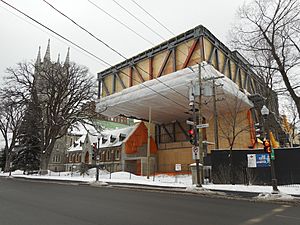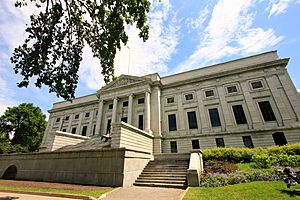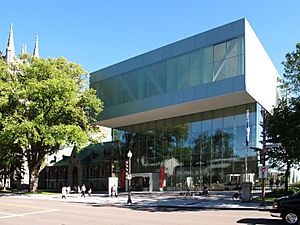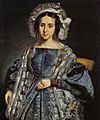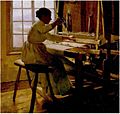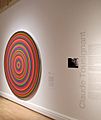Musée national des beaux-arts du Québec facts for kids
 |
|
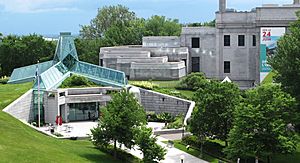
The Central Pavilion with Gérard-Morisset Pavilon in the background
|
|
| Lua error in Module:Location_map at line 420: attempt to index field 'wikibase' (a nil value). | |
| Former name |
|
|---|---|
| Established | 5 June 1933 |
| Location | The Battlefields Park, Quebec City, Quebec, Canada |
| Type | Art museum |
| Visitors | 387,333 (2017–18) |
| Owner | Government of Quebec |
The Musée national des beaux-arts du Québec (MNBAQ) is a cool art museum in Quebec City, Quebec, Canada. Its name means "National Fine Arts Museum of Quebec."
The museum is located in The Battlefields Park. It's a group of four buildings. Three of these buildings were built just for the museum. One building used to be a prison!
The museum first opened in 1933. Back then, it was called the Musée de la province de Québec. It used to have collections of natural science and old documents, but now it's all about art.
The MNBAQ has more than 40,000 artworks. These pieces range from the 16th century to today. Most of the art is by artists from Quebec. However, you can also find art from other parts of Canada and around the world.
Contents
A Look at the Museum's History
Before the museum even existed, Quebec started collecting art. They also gathered items for a natural history collection. In 1920, they began buying art from Quebec artists. This was to help support local talent.
A special law was passed in 1922. This law helped provide money to build museums in the province. Construction for the first museum building, the Gérard-Morisset Pavilion, began in 1928. It finally opened its doors to the public in June 1933.
At first, the museum was home to art, natural science, and even provincial archives. But things changed over time. In 1962, the natural history collection was moved out. The next year, in 1963, the museum's name changed to Musée du Québec.
The provincial archives also moved out in 1979. This left the museum focused only on its art collection. In 1983, the museum became a special government organization.
From 1989 to 1991, the museum got bigger. They added the Charles Baillairgé Pavilion. This building used to be a prison! Adding it more than doubled the museum's space. The old prison was turned into 12 new art galleries. It also made room for an auditorium, a gift shop, and a restaurant. A beautiful sculpture garden was finished in 1993.
In 2002, the museum got its current name: Musée national des beaux-arts du Québec. The newest building, the Pierre Lassonde Pavilion, started being built in 2013. It opened to visitors in 2016.
Exploring the Museum Buildings
The museum is located in The Battlefields Park. It has four main buildings. These are the Gérard-Morisset Pavilion, the Charles Baillairgé Pavilion, the Pierre Lassonde Pavilion, and the Central Pavilion. Tunnels connect all these buildings, making it easy to explore.
Gérard-Morisset Pavilion
The Gérard-Morisset Pavilion was the very first building made for the museum. Work on it started in 1928 and finished in 1931. Wilfrid Lacroix designed it in a grand style called Beaux-Arts architecture. Joseph-Émile Brunet created the cool sculptures on the outside.
This building opened in June 1933. It features white marble, wide steps, and carved ceilings. In 2018, the museum updated this pavilion. They made the viewing spaces brighter and made it fit better with the other museum buildings.
Charles Baillairgé Pavilion
The Charles Baillairgé Pavilion is the second building the museum uses. It's actually older than the other buildings! Charles Baillairgé designed it in 1867 to be a prison. It was built like a famous prison in New York.
This building held prisoners until 1970. After the museum bought it, they spent two years, starting in 1989, making it new. The renovations created four art galleries inside. They even kept a section of old jail cells to show its past as a prison.
Designers Charles Dorval and Louis Fortin worked on the renovation. They also designed the underground tunnel that connects this pavilion to the Gérard-Morisset Pavilion. Part of the new design was hidden under the park's landscape. This helped keep Battlefield Park looking natural. The museum opened this pavilion in May 1991.
Central Pavilion
The Central Pavilion is a glass pyramid. It's also known as the Grand Hall. This part was built during the 1989–1991 renovations. Dorval and Fortin designed it too.
The Central Pavilion sits between the Gérard-Morisset and Charles Baillairgé Pavilions. It's where visitors usually enter the museum.
Pierre Lassonde Pavilion
Construction on the Pierre Lassonde Pavilion began in 2013. It opened to the public in June 2016. This pavilion has a glass entrance from Grande Allée. This entrance leads to the rest of the museum complex in Battlefield Park.
The Office for Metropolitan Architecture designed this 14,900 square meter (160,382 sq ft) building. The main designers were Jason Long and Shohei Shigematsu. While building this pavilion, the museum's tunnels were also updated. They were turned into cool viewing spaces.
The pavilion uses a lot of glass and steel. This makes it feel open and connected to the public. The building is right next to the Saint-Dominique Church.
Building this pavilion cost about C$103.4 million. It has 2,741 square meters (29,504 sq ft) of gallery space. There's also a café in the main lobby, a courtyard, a white spiral staircase, and a gold-colored elevator. The building is named after Pierre Lassonde, who gave a lot of money to the museum. The gold color of the elevator was chosen because of his work with gold.
The Museum's Art Collection
As of March 2019, the museum's permanent collection has 40,000 artworks. These pieces are by 4,524 different artists. The art comes from Quebec, other parts of Canada, and around the world. The works date from the 16th century to today.
The museum's main goal is to show and protect art from Quebec. It also makes sure to include international art. The museum gets its art through gifts, purchases, or by ordering directly from artists. The first artworks were bought in 1920. However, only six of those first pieces are still in the collection today.
Each building in the museum holds a different part of the art collection. The Gérard-Morisset Pavilion has historical art. The Charles Baillairgé Pavilion shows modern art. The Pierre Lassonde Pavilion features contemporary art.
Selected Artworks
-
Henri Julien, La Chasse-galerie, 1906
-
Helen McNicoll, À l'ombre de l'arbre/In the Shadow of the Tree, c. 1910
-
Charles Daudelin, La Cavalière, 1963
-
Jean-Paul Riopelle, La Victoire et le Sphinx, 1963–1965
Library and Archives
The museum also has a library and archives. These specialize in art from Quebec. The library has over 13,000 files about artists. It also has books, catalogs, and videos about art in Canada and worldwide.
If you want to visit the library and archives, you need to make an appointment. Some of the information can be found online through CUBIQ. This is a central catalog for public libraries in Quebec.
See also
 In Spanish: Museo nacional de bellas artes de Québec para niños
In Spanish: Museo nacional de bellas artes de Québec para niños
- List of art museums
- List of museums in Quebec
- List of national galleries


